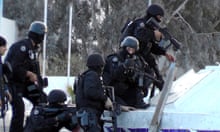Five years ago this week, the first of several victories of the Arab spring was won in Tunisia. Popular and largely nonviolent demonstrations had begun just four weeks earlier in the country’s southern interior, with its long history of resistance to central government.
Following the self-immolation of the vegetable seller Mohammed Bouazizi on 17 December 2010, the demonstrations had spread rapidly, culminating in a large rally outside the interior ministry in Tunis on 14 January. On that day, facing huge opposition and a planned general strike, the president of Tunisia, Zine al-Abidine Ben Ali, fled. He has been holed up in Saudi Arabia ever since.
Why was the apparent success of the Tunisian revolution followed by so many disasters? Can it really be true that a largely peaceful development, which inspired millions around the world, contributed to the situation faced today: internationalised civil wars in both Syria and Yemen, the rise of Islamic State, authoritarian rule in Egypt, the collapse of central government in Libya, and migrants risking all to flee these horrors?
A short answer is that getting rid of a dictatorial and corrupt ruler is not enough. Building democratic institutions, and restoring confidence in a flawed state, are much harder tasks. It was a failure to understand this that led the US and Britain into their disastrous Iraq adventure in 2003. However, it is not only the neocons and their friends who need to learn this lesson. So do advocates and practitioners of nonviolent civil resistance, who have often concentrated on the task of getting rid of dictators with less thought and planning about what comes after.
Tunisia itself remains, precariously, as the country that has achieved most political change since the Arab spring at the lowest human cost. The regime did not fall just because of Ben Ali’s departure. That was just a beginning. Within the country a long struggle began, not just to replace the most corrupt and incompetent adherents of the old regime but also to devise a new constitutional order. This took two years, and could only succeed because there was a measure of trust between the different parties involved.
What factors made it possible for Tunisia to make a transition to a multiparty democracy? Two which have often been cited are the Tunisian army’s traditional apolitical ethos and Tunisia’s cultural affinity to Europe. But a third key factor, closely related to these two, was the remarkable role of the Ennahda party.
Long before 2011, this Islamist body – very different from Islamist groups in other countries – had been developing in a strongly democratic direction. Under Ben Ali’s presidency, its experience of extreme repression led it to act in concert with other political parties. After the revolution it recognised explicitly the absolutely fundamental precondition of democracy – that parties must be willing to lose an election. In 2014 Ennahda was as good as its word, losing an election and immediately conceding.
The Tunisian success in getting rid of Ben Ali was followed in Egypt by the resignation of president Hosni Mubarak in February 2011, by Colonel Muammar Gaddafi’s death in Libya the following October, and by the departure of president Ali Abdullah Saleh from Yemen in February 2012. Four autocrats gone in just over a year.
With the exception of Libya, where events were violent from an early stage, these revolutions could easily be seen as triumphs of civil resistance. Yet none of the post-Tunisia cases ended with anything remotely resembling success.
Egypt saw an elected Muslim Brotherhood government thrown out by the army in a coup d’etat that had much popular support, but which has resulted in a regime that is no less authoritarian than Mubarak’s. The wars in Libya and Yemen demonstrated what can happen when the lid is taken off in a deeply divided society.
Meanwhile, in two countries where there were strong opposition movements but no revolution, Bahrain and Syria, there have been two very different outcomes, neither of them what the demonstrators had sought: in Bahrain, a reinforcement of the government by Saudi military intervention; and in Syria, utter disaster. Outside powers have not played a glorious role in any of this.
The trouble does not end there. In his multipart Message of Hope and Glad Tidings to Our People in Egypt, the Egyptian-born Ayman al-Zawahiri, who became leader of al-Qaida after Osama bin Laden’s assassination in May 2011, had seemed to be impressed by the uprisings in Tunisia and Egypt.
Yet his words, predictably, contained no hint of recognition that peaceful struggle might have achieved more than all of al-Qaida’s murderous demolitions. Moreover, the growth of Isis and its affiliates since 2014 has shown how extreme Islamist movements can take advantage of spaces where government has broken down. Indeed, Isis’s emphasis on the physical control of territory – which distinguishes it from al-Qaida – is a logical consequence of the power vacuums that emerged in many countries affected by the Arab spring.
What does this tale of woe say about the capacity of civil resistance to liberate people from autocracy? Three strong lessons emerge.
The first is that civil resistance does have power – and maybe sometimes too much. It can undermine the pillars on which autocracy rests. However, civil resistance may not work against a ruler, such as Bashar al-Assad in Syria, who can retain the support of a significant segment of society. And, if it does bring the pillars of autocracy down, its adherents need to recognise the existence, and serious consequences, of power vacuums.
The second lesson is that the tradition of seeing civil resistance as by nature superior to the mundane business of government is deeply problematic. Wherever it is used against a regime, there needs to be a credible plan for governing the country: in the absence of such a plan, civil resistance is part of the problem, not part of the solution. Many of the spontaneous and in some cases leaderless Arab spring movements of 2011 were unsuited to taking on the tedious roles of political parties and constitutional lawyers.
The third lesson is that in many situations, there is a case for movements to make more modest demands rather than the fall of the regime. In Jordan and Morocco, for instance, Arab spring campaigns had an essentially reformist character. It may be too soon to say how successful they have been, but they have avoided some of the catastrophes of the past five years.
The extraordinary events that followed Bouazizi’s death in a remote part of Tunisia seemed at the time a classic example of a domino effect: waves of people power toppling tyrants across the Arab world. Yet the tragedies that followed confirm that every country acts differently, as a result of their varied histories, economies, geographies and belief systems. Revolutions often spread across frontiers: witness 1848, 1989 and now 2011. But they do not necessarily travel well.








